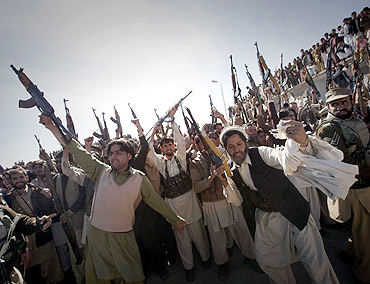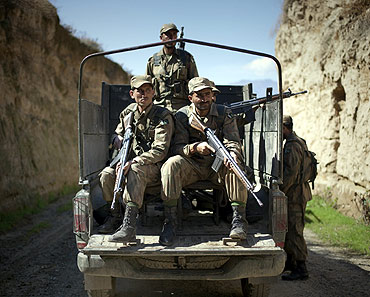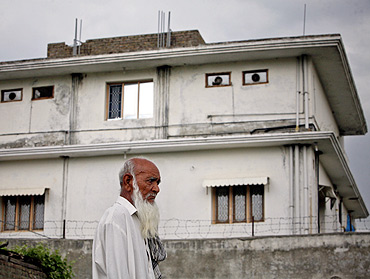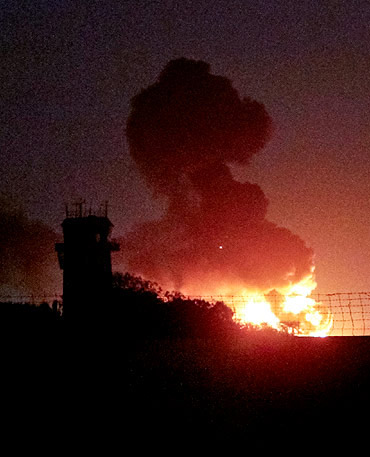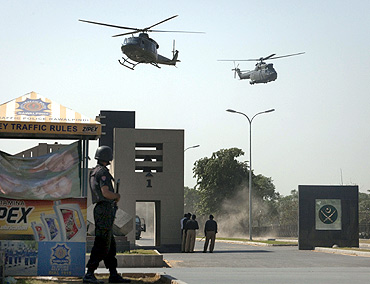 | « Back to article | Print this article |
Why Al Qaeda is now a Pakistani phenomenon
As the peril of Islamic militancy spreads like a jungle fire in almost every nook and corner of Pakistan, the Al Qaeda network keeps thriving by evolving a modus operandi which exploits its local affiliates -- the Pakistani militant groups active in Jammu Kashmir and Afghanistan -- to pursue their global jehadi agenda, says Amir Mir.
Almost a decade after the 9/11 terrorist attacks in the United States, Pakistan, despite being a key US ally in the war on terror during all those years, is undergoing a radical change, moving from the phase of Talibanisation of its society to the Pakistanisation of Al Qaeda, with many of the key Pakistani jehadi organisations, which are both anti-American as well as anti-state, having already joined hands with Al Qaeda to let loose a reign of terror across Pakistan.
The meteoric rise of the Taliban militia in Pakistan since 9/11 has literally pushed the Pakistani state to the brink of civil war, claiming over 35,000 lives in terrorism-related incidents.
Please click NEXT to read more...
Al Qaeda's new power base, separate from Afghanistan
As the US-led Allied Forces launched a military offensive in Afghanistan in 2001, the Al Qaeda leadership in Afghanistan started systematically moving its fighters across their eastern border into Pakistan, where they have effectively taken over the rugged mountainous Federally Administered Tribal Areas after joining hands with local militants.
The Al Qaeda leadership's choice of using the FATA region, especially North and South Waziristan tribal agencies as their hideout, has enabled the terror outfit to build a new power base, separate from Afghanistan.
Until recently, strategic analysts have been focusing only on the dangers posed by the growing Talibanisation of Pakistan. Yet, it has now become abundantly clear that the time has come to pay more attention to the bigger dangers posed by the Pakistanisation of Al Qaeda.
Despite Pakistan's extensive contribution to the global war on terrorism, many questions persist about the extent to which Al Qaeda and its associated outfits are operating within Pakistan.
Al Qaeda's success in forging close ties to Pakistani jehadi groups has given it an increasingly secure haven in the mountainous tribal areas of Pakistan which has also replaced Afghanistan as a key state for the training and indoctrination of Al Qaeda recruits for operations abroad and for the training of those indoctrinated and radicalised elsewhere.
Despite Osama's death, Qaeda remains a potent force
Thus, international terrorism experts believe if there is one country that matters most to Al Qaeda's future today, it is none other than Pakistan, where the fate of the last batch of jehadis trained and inspired before the 9/11 attack is being played out.
The Pakistanisation of Al Qaeda is in fact rooted in decades of collaboration between elements of the Pakistani military and intelligence establishment and the extremist jehadi movements that birthed and nurtured Al Qaeda which has evolved significantly over the years from a close-knit group of Arab Afghans to a trans-national Islamic global insurgency, dominated by more and more Pakistani militants.
With a gush of motivated youth flooding towards the realm of jehad and joining Al Qaeda cadres, Pakistan continues to be a potential site for recruitment and training of militants as the fugitive leadership of the terror outfit keep hiring local recruits with the help of their local affiliates to bolster the manpower of Al Qaeda which has clearly grown from strength to strength despite the arrest and killing of hundreds of its operatives from within Pakistan.
Terrorism experts are of the view that despite the death of Al Qaeda's founder Osama bin Laden in the May 2 American raid in Abbottabad, Al Qaeda remains a potent threat for the global peace as it keeps thriving in the Pakistan-Afghan tribal belt.
Al Qaeda, for all practical purposes, is now a Pakistani phenomenon as a good number of the anti-American sectarian and jehadi groups in the country have joined the terrorist network, making Pakistan the nerve centre of Al Qaeda's global operations.
The recent triangular syndicate of militancy in Pak
Preliminary investigations into the May 22 fidayeen attack on the Mehran Naval Base in Karachi suggest it was a coordinated operation involving Al Qaeda's interim chief Commander Saif Al Adal, who is based in North Waziristan, Commander Ilyas Kashmiri, a Pakistani who is also operating from the same area and counted among Al Qaeda's top military strategists, the Tehrik-e-Taliban Pakistan and the Punjabi Taliban, a term used to describe the Punjab-based jehadi groups who are opposed to, and fighting, the Pakistani state as well as the United States.
Terrorism experts believe that Al Qaeda and the Tehrik-e-Taliban Pakistan have teamed up with the Punjabi Taliban in recent years to form a triangular syndicate of militancy, with an aim to destabilise Pakistan, whose political and military leadership has been siding with the "forces of the infidel" in the war on terror.
Therefore, the Al Qaeda-Taliban alliance has gained an edge in Pakistan because of the support the local jehadi groups provide. Ideological ties bind the Al Qaeda, the TTP, and the Punjabi Taliban to throw out international forces from Afghanistan.
These three share intelligence, human resources and training facilities, and empathise with each other as the US-Pakistan forces -- however strained the relationship between the two countries may be -- hunt and target them.
These three initially came together at the time the United States invaded Afghanistan post-9/11, prompting the Al Qaeda and the Afghan Taliban to rely on local partners such as Pakistani pro-Taliban tribes, anti-US and anti-Shia organisations like the Lashkar-e-Jhangvi and jehadi mercenaries in Pakistani religious seminaries and militant groups for shelter and assistance.
The ties between local militant groups and Al Qaeda were cemented further as the Afghan Taliban's astonishing successes against the US-led allied forces prompted the US to increase drone attacks in the tribal areas and turn the heat on Pakistan to crack down on the TTP and others.
However, this axis of evil remains an informal alliance which is mainly meant to protect and support each other.
But what gave the alliance a fillip was the migration of battle-hardened Pakistani commanders from the battlefront in Jammu Kashmir to the Waziristan region in FATA. As things stand now, the trouble-stricken Waziristan region has become the new battlefield for the pro-Kashmir militants, who have already joined hands with the anti-US Al Qaeda elements.
Commanders like Kashmiri helped garner the Qaeda cause
Information collected by Pakistani agencies shows the presence of fighters belonging to several pro-Kashmir jehadi groups, many of which have apparently fallen out of favour with Pakistani military and intelligence establishment.
These groups, which include Harkatul Jehad-al-Islami, Harkatul Mujahideen, Al Badar, Jamaatul Furqaan and the renegade elements of Jaish-e-Mohammad and Lashkar-e-Tayiba, have strong connections with Al Qaeda in terms of operational collaboration and logistical support.
Veteran jehadi commanders like Ilyas Kashmiri of HuJI and Badr Mansoor of Al-Badar were the first ones to have adopted Al Qaeda's ideology -- that the weakening of the world's only superpower, the United States, is essential for the survival of the Muslim world.
Commanders like Kashmiri brought with them contacts in the lower echelons of the Pakistan establishment, intricate knowledge of the Pakistan terrain, and their skills in fighting, which helped create a new army for Al Qaeda in South Asia.
These developments have given Al Qaeda a strong position in South Asia, especially in Pakistan, where the terrorist outfit can effectively manipulate local jehadis to join its ranks to promote its cause.
One such militant commander who had joined Al Qaeda and has risen in the ranks as the chief military strategist of the outfit is Ilyas Kashmiri, who is believed to be the second-in-command of Al Qaeda's interim chief, Saif Al Adal.
Despite reports of his possible death in an American drone attack in the Wana area of South Waziristan on June 3, neither Washington nor Islamabad has confirmed Kashmiri's death so far.
Kashmiri is considered brutal and goal-oriented just like his Egyptian partner Saif Al Adal who has substantial experience cooperating with other anti-US militant groups.
While Saif Al Adal has served as a colonel in the special forces of the Egyptian Army, unconfirmed reports say Ilyas Kashmiri used to be a part of the Special Services Group of the Pakistan Army in the 1990s.
No wonder then, the Pakistan military is unable to thwart deadly terror attacks on its personnel and assets. Working as Saif's second-in-command is Kashmiri, one of the most high-profile Al Qaeda leaders, with a Pakistani bounty of Rs 50 million on his head.
He was labelled a "Specially Designated Global Terrorist" by the United States in 2010 while the United Nations added him (the same year) to its blacklist established under UN Security Council Resolution 1267.
Brigade 313's bloody terror trail
What prompted these actions was the fact that a website connected to Al Qaeda's military arm in Pakistan sprang up on the Internet around June 2010, titled "The Brigade 313 Website" and blazoning a flag with words "Al Qaeda Brigade 313" in the centre, while the text describing the Harkatul Jehadul Islami, Lashkar-e-Jhangvi, Jundullah, and Tehrik-e-Taliban Pakistan occupies the four corners of the flag.
Once inside the Al Qaeda Brigade 313 web page, a banner appears with images of slain Al Qaeda chief operational commander Mustafa Abu Yazid and ideologue Abu Yahya al Libi on the left and an image of Ilyas Kashmiri on the far right.
Brigade 313 is Al Qaeda's military organisation in Pakistan, and is made up of Taliban and allied jehadi groups. Jehadis belonging to Lashkar-e-Jhangvi, Harkatul Jehadul Islami, Jamaatul Furqaan, Jundullah, and renegade elements of Jaish-e-Mohammad and Lashkar-e-Tayiba are known to have merged with Al Qaeda in Pakistan, and the group operates under the name of Brigade 313, led by Kashmiri.
The Brigade 313 has been behind many high-profile terror attacks inside Pakistan, including the October 10, 2009 fidayeen attack targeting the general headquarters of Pakistan Army in Rawalpindi.
The commando assault was carried out after a US drone targeted Kashmiri and reportedly killed him in North Waziristan on September 14, 2009. Yet, hardly a month after his reported death, Kashmiri re-surfaced and promised retribution against the United States and its proxies, saying the Americans were right to pursue him.
"They know their enemy quite well. They know what I am really up to," Kashmiri had stated in an interview with Asia Times Online.
Kashmiri, who is on the record as swearing allegiance to Afghan Taliban leader Mullah Omar as far back as 1999, is in fact a walking lesson for the Pakistani military establishment on how not to create non-state actors because he has killed more Pakistanis than anyone else and more khakis than civilians.
